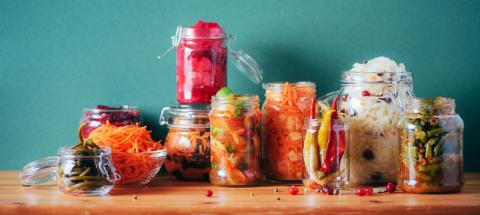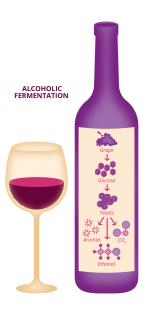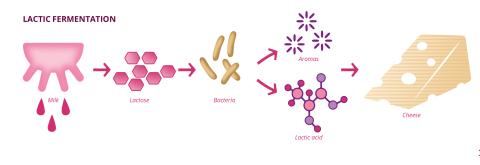
Fermented products: the promise of healthier, more sustainable food?
This article was originally published in L'Édition n°26.
Fermented products such as cheese, bread and wine are the result of centuries-old know-how that mankind has enjoyed for millennia. Regarded as a lever for healthier, more sustainable food, fermentation is now attracting renewed interest from scientists, including researchers at Université Paris-Saclay, who are working to gain more insight into the composition of these products and their underlying biochemistry, their impact on human health and the environment, and the sensory perception of their future consumers.
What do bread, wine, sausage, sauerkraut and even chocolate have in common? All these products are the result of a biological transformation brought about by micro-organisms: fermentation. According to historical accounts, the process of fermentation has been known and mastered since at least the Neolithic age, a key period at the end of Prehistory characterised by profound social and technical changes among human groups (in France, this period was between 6,000 and 2,000 BC). It is thought to have emerged independently in different civilizations, and can be found today in various specialties around the world: miso paste in East Asia, kimchi in Korea, akpan in Africa, wine in Europe... Having long been produced on an artisanal basis, fermented foods started to be industrialised in the 19th century, following French physicist and chemist Louis Pasteur's discovery of the role of brewer's yeast Saccharomyces cerevisiae in alcoholic fermentation. Today, fermented foods account for 5 to 40% of human diets, depending on the region of the world.
Fermentation has become so commonplace thanks to its many advantages, in particular in preserving food and improving its nutritional value, taste, texture and colour. But how does this miraculous transformation work from a chemical perspective? The process, brought about by micro-organisms, bacteria or fungi, consists in converting the carbohydrate molecules present in an original product into acid, gas or alcohol molecules, in order to extract a source of energy used for them to function correctly. The reaction then leads to a new food, with a different texture, taste or nutritional content from the original.
There are a wide variety of fermentations performed by different species of micro-organisms and which involve different reagents and products: for example, lactic acid fermentation, performed by bacteria including Lactobacillus, which transforms the lactose in milk into lactic acid. That is how we get yogurt. Alcoholic fermentation is also a common process, whereby carbohydrates such as glucose and fructose, found in fruit in particular, are transformed into ethanol. This is how we get wine from grapes.
Cheeses: microbial diversity with a variety of origins
Historically, producing fermented foods only involved the micro-organisms already present in the original product or its direct environment, but today the process relies on ferments (or micro-organisms) added to the product during the manufacturing process, to better control the transformation. This is the case with cheeses, for example, where the vast majority of cheese producers use microbial ferments during milk processing. The official list of ferments currently used includes around a hundred bacteria and slightly less species of fungi. But according to Françoise Irlinger, a researcher at the Paris-Saclay Food and Bioproduct Engineering laboratory (SayFood - Univ. Paris-Saclay/INRAE/AgroParisTech), "we observe four to five times more microbial species in cheeses, and in particular in PDO cheeses", proof that adding ferments is not the only source of microbial diversity in cheeses.
It's the origin of this diversity that Françoise Irlinger and her team set out to understand in their study launched in 2017. "PDO cheeses are high quality products made with traditional know-how, in a well-defined 'terroir', in accordance with specifications imposed by the sector. However, over the past 15 years or so, professionals have observed a gradual decline in microbial diversity, due to changes in milking and processing practices in response to health concerns. The idea was therefore to identify the parameters that foster this diversity, in order to maintain the quality of these cheeses that consumers want," explains the microbiologist.
For this, the scientists worked closely with professionals from the 44 mature PDO cheese sectors, who each provided them with ten cheese samples representing the diversity of the sector and the associated milk. At the same time, they also collected data on around a hundred variable parameters, such as the dairy breed, the cattle feed and the maturing temperature and humidity. To assess the microbial diversity present in the samples, the researchers then carried out metagenomic studies. This analysis involves determining all the microbial genomes present in the sample, without first having isolated the individual species, which are often difficult or impossible to grow in a laboratory. Based on this global sequencing, the scientists were able to use bioinformatic processing to identify individual species.
By cross-referencing these metagenomic data with parameters for cheese production, Françoise Irlinger and her team identified microbial species that are known to be cultured as ferments, as well as numerous other species originating directly from the milk or the cheese-making environment, and which were never added. These endogenous micro-organisms depend on the dairy species, the season and the topography, but also on the preparation of the cheese, which may or may not favour certain microbial species. The study showed that the microbial specificity of each cheese, which gives it its unique taste, comes from the terroir and the various production practices, ranging from the breeding of the livestock to the maturing cellar.
Microbial groups with uncertain roles
Which of these microbial populations is ultimately responsible for transforming the product? The answer is far from obvious. "Various microbial groups are involved in the cheese-making process. At the start, it's the lactic acid bacteria present in the milk and the environment that acidify the milk and give it texture. These bacteria are highly adapted to this dairy environment, and are therefore often cultured," explains Françoise Irlinger. While the first phase of cheese-making is well known because it has been extensively studied, the second phase, the maturing of the cheese, is much less known.
"We don't know much about the pigmentation and maturing processes, which are clearly highly complex and involve a wide variety of micro-organisms," the researcher assumes. Obtaining this information would help professionals in the PDO sectors in adapting to climate change. Indeed, a succession of extreme climate events, such as heatwaves, will oblige them to modify their specifications. It is therefore important to have a frame of reference to work from.
Fermented foods of plant origin: a production process that is still too haphazard
Nevertheless, the microbial diversity of products of animal origin, such as cheese and yoghurt, is now completely controlled thanks to the addition of listed ferments. This is not the case with traditional fermented foods of plant origin. For most of these, fermentation occurs spontaneously from micro-organisms present on the underlying food and in the environment, without ferments being added. The associated species and the mechanisms involved are poorly understood from a scientific perspective, which makes producing these fermented foods of plant origin more haphazard, although industrial groups are managing to ensure a standardised product, through experience. This is the case with sauerkraut. "If you make sauerkraut at home, it will never taste the same from one time to the next," explains Stéphane Chaillou, director of research at the MICALIS Institute (Univ. Paris-Saclay/INRAE/AgroParisTech).
The Metasimfood project, funded by the French National Research Agency (ANR) and coordinated by Stéphane Chaillou, focuses on the fermentation of cabbage and grapes into wine, and the impact of climate change on these traditional processes. Indeed, as is the case for cheese, the ecological transition and the growing interest in healthy food are having an impact on agricultural practices (prioritising organic farming) and production methods (less sulfites and salt). These effects, combined with the effects of climate change, are impacting the microbial species present in grapes and cabbage, and the nutrients they contain. All these elements have a direct impact on the fermentation. "As the grapes are sweeter in warmer weather, the micro-organisms have more sugar to transform into alcohol, which means that the wines contain increasingly more alcohol," explains Stéphane Chaillou. The Metasimfood project is aiming to better understand and control this transformation, with the ultimate aim of developing new bacterial consortia to be used as ferments that are more suited to new processes.
The benefits of fermented foods for the human gut microbiota
Fermented foods are therefore endowed with a microbiota, a term that designates the rich and diverse group of micro-organisms within a given environment. But it is not only fermented foods that have a microbiota. The human gut also contains an abundant population of micro-organisms, estimated at between ten and one hundred billion cells. These bacteria, fungi, viruses or archaea have been living in the guts of their human hosts since the latter's childhood, forming a symbiotic relationship with them: the individual hosts them and provides them with nutrients via the diet, and in return they are beneficial to the host.
The gut microbiota offers various benefits for human health: it aids digestion, activates the immune response, prevents pathogens from establishing themselves and even interacts with the brain. While the structure of the microbiota forms during an individual's earliest years and remains stable into adulthood, it nevertheless undergoes fluctuations throughout the host's life. "Our microbiota is resilient but still malleable. You can compare it to a forest that remains broadly the same from one year to the next, but if the climate changes, it will gradually adapt and its species will change," explains Patrick Veiga, director of research at the MICALIS Institute. "In the case of our microbiota, the climate is long-term dietary habits." A diet rich in fermented foods, for example, will influence the structure of the population of micro-organisms present in the gut, as confirmed by a study in which the researcher recently participated, and which showed a direct link between the consumption of yogurt and the composition of the gut microbiota.
But occasionally consuming fermented products will not significantly change the microbiota. Patrick Veiga confirms: "The bacteria and fungi present in fermented foods generally do not establish themselves in the gut. They are just passing through, but interact with our microbiota through the metabolites they produce." Occasionally consuming fermented products therefore has a one-off effect on the function of the microbiota, whereas long-term consumption has a more lasting effect, whereby the gut population is permanently restructured. However, not all microbiota are equally benign towards micro-organisms in fermented foods. Together with his colleague Joël Doré, Patrick Veiga has identified two types of microbiota: permissive microbiota, which interact with exogenous micro-organisms, and resistant microbiota, which are impervious to the contributions of fermented foods. More findings are needed to better understand these microbiota and their differences. But this study highlights the importance of personalising diets, which do not have the same effect on each individual and their unique microbiota.
While the link between the microbiota and human health is now very well documented, the impact of fermented foods in this domain is not yet adequately documented. "The difficulty with this field of investigation is that it is an extremely diverse range of products," underlines Patrick Veiga. However, some products are already well characterised, such as yoghurt. It has been shown, for example, that eating yoghurt reduces the risk of diabetes, and that the microbiota plays a role in this protective effect. "You also have to take into account culinary traditions. If we consume these products in such large quantities today, it's because they've been selected in one way or another for their health benefits."
DOMINO: fermented foods as levers for a healthy ecological transition
The DOMINO project, led by the MICALIS Institute, was launched to gain more insight into the link between fermented foods, microbiota and health, and to propose more sustainable food solutions. Funded by the European Union's Horizon programme, this project aims to develop new plant-based fermented products that are both healthier and more environmentally sustainable. Since they are not of animal origin, these products have a lower carbon footprint when produced. "On the other hand, fermentation has a beneficial effect on the energy footprint of finished products, as it allows food to be kept fresh without the need for an electric refrigerator and reduces plastic packaging," explains Stéphane Chaillou, coordinator of the project.
By starting with a study of fermented plant-based foods from around the world, the scientists are looking to identify their microbial biodiversity. At the same time, they also want to better understand the effect of these fermented foods on gut microbiota and health. The aim is to develop new fermented foods that can then be commercialised on the European market. Stéphane Chaillou explains: "For these new products, we're going to use legumes and cereals that currently are not used much in Europe, such as small spelt and teff. These plants, grown today in Africa, are more resistant and require less water than our traditional cereals, while offering more nutritional value." Developing take-up of these plants also offers an early solution to the aridification of southern Europe.
One of the challenges of the DOMINO project is to get these food prototypes accepted not only by consumers, but also by farmers, who are being urged to adapt their crops. To this end, the project includes a collaborative science component, in the form of a living lab - a place where different players in society can work together. "These spaces for co-creation are essential to ensure that we don't miss out on any knowledge," stresses Stéphane Chaillou.
Increasingly sought-after foods
Because one of the challenges is to win over future consumers with these new food products. One promising sign is that the general public already has a very real interest in fermented foods. In 2017, these foods were cited in the top 10 food trends by British magazine New Nutrition Business, demonstrating the growing appeal of these products. They are currently especially popular for the diversity of their flavours and, more recently, for their health benefits, as many of them are synonymous with low-processed food.
This relationship between consumers and fermented products is the subject of a study led by Anne Saint-Eve and her team at the Sayfood laboratory. "I carry out sensory analysis. I try to understand how a food is perceived by consumers and to make the link with its composition," the researcher explains. To this end, Anne Saint-Eve and her team evaluate products on two panels of participants, the first trained to taste and describe the products studied with a common, consensual vocabulary, and a second, untrained panel, to assess how context influences the experience. The researchers then make a link to the composition of the products, to gauge how to meet consumer expectations, while respecting the constraints of the various players involved in the design process.
In particular, the researcher applied this method to the study of a fermented cheese-like product made from a mixture of peas and animal milk, the idea being to make a transition to healthier, more sustainable foods without sacrificing on taste. Variations of this fermented product, which contain a rising proportion of peas compared with animal milk, were proposed to a panel of 240 people. "Half were informed in advance about the nutritional benefits of the product, while the other half were informed about its environmental benefits," explains Anne Saint-Eve.
In both cases, the products containing more than 75% plant-based ingredients were not well received at all. The participants liked the products with less than 75% plant milk more once their nutritional or environmental benefits were revealed. "It's clear that the first factor in whether someone likes a food product is its taste, followed by the potential health benefits, and then the environmental impact," concludes the researcher. This last point is also the focus of the study of the SayFood laboratory team, which is measuring the environmental impact of pea cheeses using life cycle analyses. "The idea is to link the environmental impact of the product, the ability of micro-organisms to adapt to these new matrices, and consumer perceptions." In this way, we hope to create new products that are beneficial to health, environmentally-friendly and, above all, liked by consumers.
Fermented foods have been part of human diets for thousands of years, but today they offer a real solution to the challenges of healthy, sustainable human nutrition. With their production and storage methods that have a low environmental impact, better digestibility and direct or indirect health benefits via the microbiota, these products are increasingly sought-after by consumers. So, will they be filling up the plates of the future?
References :
- Irlinger et al., A comprehensive, large-scale analysis of “terroir” cheese and milk microbiota reveals profiles strongly shaped by both geographical and human factors, ISME Communications, 2024.
- Veiga et al. Changes of the human gut microbiome induced by a fermented milk product, Sci Rep, 2014.
- Saint-Eve et al., Consumer preferences for new fermented food products that mix animal and plant protein sources, Food Quality and Preference, 2021.
- Zhang et al., Ecological robustness of the gut microbiota in response to ingestion of transient food-borne microbes, The ISME Journal, 2016.

This article was originally published in L'Édition n°26.
Find out more about the journal in digital version here.
For more articles and topics, subscribe to L'Édition and receive future issues:



